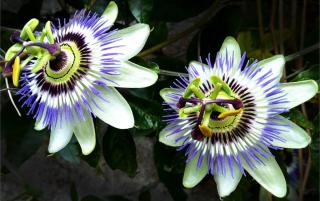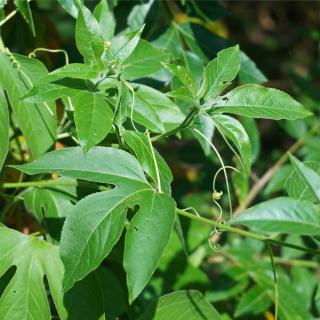

Blue passion flower or Passiflora caerula is a climbing vine of the passion flower family.
Key Passion flower facts
Name – Passiflora caerulea
Family – Passifloraceae or passion flower family
Type – vine
Height – 16 to 32 feet (5 to 10 m)
Exposure – full sun
Soil – ordinary but well drained
Foliage: evergreen – Flowering: May to October
It was originally found in the tropical Americas and is frequently cultivated in hotter regions of the planet.
In the days of Moctezuma, passion flowers were grown in the Aztec lords’ gardens.
They were introduced in Europe in the 17th century and the plant immediately became part of local medicinal plant lore as a famed antispasmodic agent.
In the flower itself, the faith-imbued people of the time imagined that the flower’s different parts symbolized various instruments used in the Passion of Christ (hammer and nails, crown of thorns…). This is what gave the flower its name.
The passion flower that is cultivated in our temperate latitudes is the Passiflora caerulea or blue passion flower.

The passion flower must develop its root system in the ground over the first year before the cold sets in.
There are 2 techniques to multiply your blue passion flower: sowing from seeds and propagating cuttings.
Passion flower seeds can be sown all year long; note that seeds must be soaked for 24 hours before sowing.
You can also multiply passion flower with cuttings over the summer, ideally from June to September.
Prune the plant after it has bloomed in order to reduce its growth.
It develops quickly, and pruning will serve to increase the following year’s flower-bearing.
In case of harsh winter climate, prefer planting in pots that can be brought in frost-free storage before temperatures fall below freezing.
Conversely, in case of mild winter climate, you may plant your Passiflora caerulea in the ground and mulch its base with a thick layer of mulch.
Water your passion flower generously after planting and then again during the summer in case of strong heat waves.
Passion flower water needs depend on temperature and climate, so check if it would rain before watering.
The Passiflora genus numbers over 500 species and they don’t all share the same cultivation needs nor do they cope evenly in similar climates.
Passiflora caerula is practically the only cultivar that is grown outdoors in our temperate climates, and here it is together with other interesting varieties:

Passion flowers have long flower-bearing twining stems divided in three twisting lobes that let the plant hang on outcropping objects.
Passion flowers grow mostly in milder Asian and Central American climates. However, several varieties also grow in more temperate climates like the blue passion flower, Passiflora caerulea.
You can let it grow alongside a wall with a lattice, and it will perfectly embellish a pergola or serve as an indoor plant.
 assion flowers or their extracts are famed for soothing the nervous system, they are often used today for their sedative and hypnotic properties. Passion flower is recommended in cases of insomnia when brought upon by alcohol poisoning, menopause, nervous stimulation or neurasthenia. In persons overworked or vulnerable to anxiety, passion flower reduces anxiety. Good to know: the sleep it induces is natural. Using passion flower leads neither to addiction nor to nervous depression. Be not afraid!
assion flowers or their extracts are famed for soothing the nervous system, they are often used today for their sedative and hypnotic properties. Passion flower is recommended in cases of insomnia when brought upon by alcohol poisoning, menopause, nervous stimulation or neurasthenia. In persons overworked or vulnerable to anxiety, passion flower reduces anxiety. Good to know: the sleep it induces is natural. Using passion flower leads neither to addiction nor to nervous depression. Be not afraid!Passion flower infusion, let 1 oz (25 g) of flowers steep 25 minutes in 1 quart (1 liter) boiling water. Drink 2 to 3 cups daily, with at least 1 cup an hour before going to bed. This reduces anxiety, enhances sleep, and helps withdraw from addictions like alcohol.
Passion flower tincture – macerate 7 oz (200 g) of dried, crushed flowers in 1 quart (1 liter) of 60% (volume) alcohol. Close the bottle and keep for 10 days, shaking it from time to time. Filter. Drink 40 to 50 drops of this tincture before sleeping.
High doses of passion flower may lead to sleepiness or even provoke reduced states of consciousness. So… be careful
Read also:
In colder climates, cover the base well with a thick layer of mulch over the winter to protect it from the cold.
My Passion flower vine is growing quite fast, producing plenty of buds, but few are blooming.
Hello Sherry! The blooming only really gets serious at the end of Summer. Before that, I’ve also experienced buds not reaching the opening-up stage. Most of the blooming, at least in temperate climates, occurs in August-September. Even then, maybe only about 50% of the buds would reach the flower stage, depending on the weather. This really is a tropical plant and we simply can’t get the same level of blooming in the USA and in Europe as it would in more equatorial latitudes. Full sun helps a lot.
Another tip, especially if it’s in a pot, is to remember to add fertilizer that has lots of micro-nutrients and trace minerals, with less nitrogen and more potassium. Comfrey weedy tea is excellent for this, horsetail as well, though there might also be other weeds you can make your fertilizer out of.